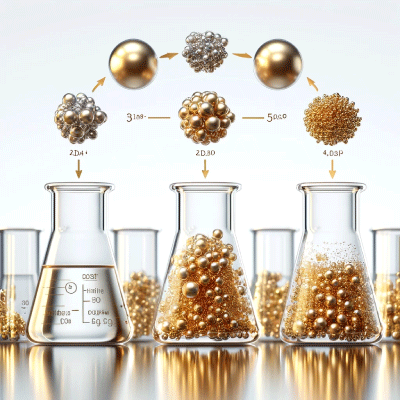The Turkevich Method: A Guide to Synthesizing Gold Nanoparticles | Nanopartz™
Introduction to the Turkevich Method
The Turkevich Method is a widely recognized chemical process used to synthesize gold nanoparticles. Developed in the 1950s by J. Turkevich and colleagues, this method remains one of the most commonly used approaches for producing colloidal gold due to its simplicity and reliability. This process primarily utilizes chloroauric acid (HAuCl₄) and citrate to generate gold nanoparticles with controlled sizes and shapes, making it a foundational technique in nanotechnology research.
How the Turkevich Method Works
The Turkevich Method relies on a reduction reaction where citrate ions reduce gold ions to form elemental gold nanoparticles. The steps in the Turkevich Method typically include:
- Preparation of Gold Precursor Solution: Dissolve chloroauric acid in water, creating a gold ion solution.
- Addition of Reducing Agent: Add sodium citrate to the solution. Citrate ions reduce the gold ions (Au³⁺) to elemental gold (Au⁰), and the gold atoms begin to nucleate, forming nanoparticles.
- Nanoparticle Formation and Stabilization: As nanoparticles form, citrate ions also stabilize the particles, preventing them from aggregating. By adjusting the concentration of citrate, the size of the nanoparticles can be controlled.

Key Parameters Affecting Nanoparticle Properties
Several variables influence the final properties of nanoparticles synthesized via the Turkevich Method. These include:
- Concentration of Sodium Citrate: Higher citrate concentrations tend to produce smaller particles due to faster nucleation rates.
- Reaction Temperature: Temperature adjustments can lead to variations in particle size and shape.
- pH Levels: Altering the pH affects the rate of nucleation and stabilization, impacting the size distribution of nanoparticles.
Applications of Gold Nanoparticles Synthesized by the Turkevich Method
Gold nanoparticles produced through the Turkevich Method are widely used in various scientific and industrial applications, including:
- Biomedical Imaging: Gold nanoparticles are ideal for optical imaging and photothermal therapy due to their biocompatibility and unique optical properties.
- Catalysis: Gold nanoparticles act as efficient catalysts for various chemical reactions, including hydrogenation and oxidation.
- Biosensors: Functionalized gold nanoparticles improve the sensitivity of biosensors in detecting biomarkers and pathogens.
- Drug Delivery: Gold nanoparticles are used as carriers for targeted drug delivery, improving therapeutic efficacy.
Advantages and Limitations of the Turkevich Method
Advantages:
- Simplicity: The Turkevich Method is straightforward and does not require complex equipment or procedures.
- Cost-Effectiveness: The reagents used (chloroauric acid and citrate) are readily available and inexpensive.
- Scalability: The method is easily scalable for larger batches of gold nanoparticles.
Limitations:
- Size Control: While generally effective, controlling nanoparticle size with precision is more challenging than with more advanced synthesis methods.
- Shape Limitations: The Turkevich Method primarily produces spherical nanoparticles, limiting applications where specific shapes are required.
Conclusion
The Turkevich Method remains a valuable and widely-used technique for synthesizing gold nanoparticles. Its accessibility and efficiency make it an essential tool in nanotechnology research and development. Whether in catalysis, medicine, or imaging, gold nanoparticles synthesized via the Turkevich Method continue to enable breakthroughs in multiple scientific fields.
For more information and to explore their products, visit the Nanopartz™ website. Happy researching!
Go here for Nanopartz Gold Nanoparticles

